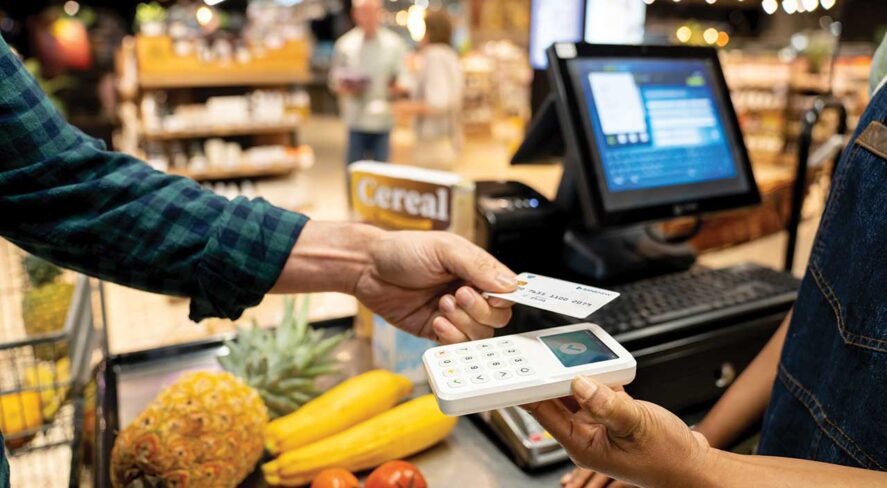The Power of Layered Security

Defenses should not be limited to the internal environment

Security is no longer just a single-layered effort. Whether managing a retail store, hospital or warehouse, securing a property requires a multifaceted approach that considers both physical and digital threats.
By implementing a layered security strategy, businesses can effectively deter, detect and respond to security incidents in real time, before they escalate. This ultimately enables a proactive approach to security rather than a reactive one.
Understanding the Zones of Influence
A successful security strategy extends beyond a facility’s immediate interior. The Loss Prevention Research Council’s “Zones of Influence” model identifies five distinct security zones, ranging from interior points of interest to the broader community. Addressing all five zones ensures a comprehensive security posture.
- Zone 1: Specific interior points or assets (e.g., cash registers, high-value merchandise)
- Zone 2: Specific interior category areas (e.g., stockrooms, employee-only spaces)
- Zone 3: Overall store entry and interior
- Zone 4: Parking lot entry and interior
- Zone 5: Cybersecurity and surrounding community
Many businesses primarily focus on Zones 1 through 3, overlooking the benefits of securing outer areas. However, threats often originate beyond the immediate premises. By integrating security technologies across all five zones, businesses can significantly reduce criminal activity before it reaches their doors.
Essential Security Technologies for a Layered Approach
Video Surveillance and Monitoring
Video surveillance remains a cornerstone of security, providing real-time monitoring and recorded footage for post-incident investigations. High-definition cameras placed strategically across all zones – inside buildings, in parking lots and at entry points – enhance visibility and deterrence.
Modern surveillance solutions leverage artificial intelligence (AI)-powered analytics to detect unusual activity, unauthorized access and potential threats in real time. Additionally, remote access capabilities enable security teams to monitor premises from anywhere, ensuring continuous protection.
Access Control Systems
Restricting unauthorized access is crucial for safeguarding sensitive areas like stockrooms, data centers and health care facilities. Various access control methods include:
- Biometric authentication: Facial recognition, fingerprint scanning and palm recognition offer high security for restricted spaces
- Key card and fob systems: Used in commercial buildings, these solutions provide controlled access while allowing for easy permission adjustments
- Visitor management systems: Particularly valuable for hospitals and office complexes, these systems track and log visitors, ensuring that only authorized personnel enter restricted areas.
Alarm Systems
Alarm systems serve as both deterrents and response triggers. Advanced alarm solutions integrate with motion sensors, glass break detectors, and emergency alerts to provide instant notifications in case of intrusion, fire or other incidents.
Retailers, warehouses and health care facilities can benefit from silent alarms connected to security teams or law enforcement, ensuring rapid response times when threats arise.
Wearable Security Devices
For frontline employees, personal security devices such as body-worn cameras (BWCs) provide real-time documentation and incident deterrence. Studies have shown that BWCs can reduce workplace violence incidents by nearly 45 percent, making them an essential tool for security personnel and customer-facing employees.
Additionally, wearable panic buttons allow employees in high-risk environments, such as hospitals and retail stores, to discreetly call for help when facing threats.
License Plate Recognition (LPR) Technology
LPR cameras enhance security by monitoring vehicle activity at entry and exit points. These cameras help businesses:
- Identify known offenders or suspicious vehicles and bring them to the attention of security teams
- Track unauthorized parking lot activity
- Aid law enforcement in criminal investigations
LPR technology is particularly effective in deterring organized retail crime and identifying repeat offenders targeting specific locations.
Weapons Detection Systems
Weapons detection technology is increasingly vital in environments where public safety is a priority, such as shopping centers, health care facilities and large event venues. Advanced systems can detect concealed weapons using AI-powered scanners, alerting security personnel before threats escalate.
By integrating weapons detection with other security measures like access control and video surveillance, businesses can create a robust system to prevent violent incidents.
Mobile Surveillance Units
For businesses that need flexible security solutions, mobile surveillance units provide temporary yet high-powered monitoring in areas like parking lots, construction sites and outdoor venues.
These units can be rapidly deployed and equipped with solar-powered cameras, motion detection technology, and two-way audio communication to enhance situational awareness.
Cybersecurity and Data Protection
While physical security is essential, cybersecurity plays an equally critical role in protecting business assets. Businesses should implement:
- Network monitoring tools to detect and prevent cyber threats
- Multi-factor authentication to protect sensitive systems
- Encryption protocols to secure customer and business data
Cybersecurity should also be integrated with physical security measures, ensuring a holistic approach to threat prevention.
Bringing Technology Together in a Single Pane of Glass
A unified security platform integrates multiple security tools into a single pane of glass, allowing businesses to streamline monitoring, enhance situational awareness, and respond to threats more efficiently. By consolidating various security technologies into one interface, organizations can improve coordination and ensure a more proactive security posture. Businesses can implement:
- Real-time monitoring to track live feeds, analyze security data, and respond to incidents as they occur
- Multisystem integration to unify video surveillance, access control, alarm systems and cybersecurity tools into a single, centralized platform
- Incident analysis and trend tracking to refine security strategies and proactively mitigate emerging threats
A single-pane-of-glass security solution reduces blind spots, improves response times, and provides comprehensive oversight, ensuring businesses can effectively prevent and manage security incidents.
Strengthening Security with Strategic Policies
Technology alone cannot ensure complete security. Businesses must also establish strong security policies to complement their tools. Here are key strategies to enhance security effectiveness.
Regular Security Assessments
Conducting periodic risk assessments helps businesses identify gaps in their security measures and adjust strategies accordingly. This includes reviewing surveillance footage for blind spots, testing alarm and access control systems and analyzing security incident reports for trends.
Employee Training and Awareness
Even the most advanced security systems are ineffective without trained personnel. Employees should receive ongoing training in recognizing and reporting suspicious activity, properly using security technologies, and responding to emergency situations.
Incident Reporting and Documentation
Businesses should implement clear reporting procedures for security incidents, ensuring that every event is properly logged and analyzed. A structured reporting system helps security teams identify crime patterns, supports law enforcement collaboration and improves future security strategies.
Collaboration With Law Enforcement
Building strong relationships with local police departments and security agencies can improve response times and ensure better coordination in the event of a threat. As part of establishing direct communication channels with law enforcement, businesses should participate in public safety initiatives and share relevant security data to aid investigations.
A Foundation for Sustainable Success
Security threats are constantly evolving, and businesses must stay ahead by adopting adaptive, layered security measures. Implementing a multi-zone security strategy – supported by modern technologies and proactive policies – ensures long-term success and safety.
By taking a comprehensive approach that integrates video, access control, alarm systems and cybersecurity, businesses can create a secure environment for employees, customers and assets. Ultimately, layered security is not just about preventing crime; it is about fostering a safe, resilient and thriving business environment.
